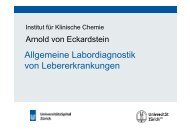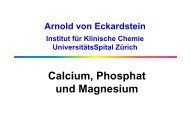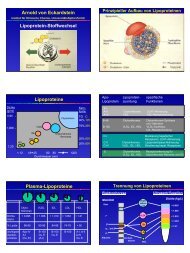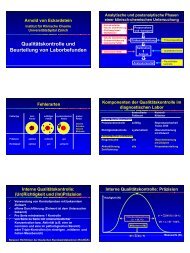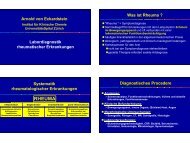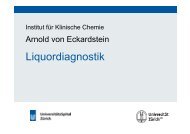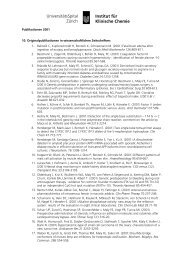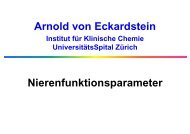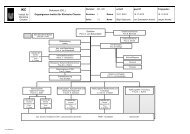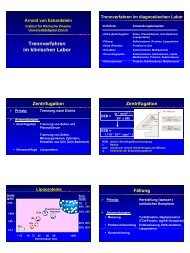Akademischer Bericht 2002 - Institut für Klinische Chemie ...
Akademischer Bericht 2002 - Institut für Klinische Chemie ...
Akademischer Bericht 2002 - Institut für Klinische Chemie ...
Sie wollen auch ein ePaper? Erhöhen Sie die Reichweite Ihrer Titel.
YUMPU macht aus Druck-PDFs automatisch weboptimierte ePaper, die Google liebt.
substances as well as smooth muscle cell proliferation. Some of thesepotentially anti-atherogenic activities are exerted by apolipoproteins (e.g.apoA-I), others by enzymes (e.g. paraoxonase) and others by lipids (e.g.phospholipipids and lysosphingolipids). We therefore investigate the regulationof plasma levels and composition of HDL. In addition HDL have to enter thevascular wall to exert many of their anti-atherogenic activities. Themechanisms mediating the transport of HDL through the endothelial layer,which lines the intimal surface of all blood vessels, are poorly understood. Thereceptors and transporters needed for endothelial HDL uptake, intracellulartransport and re-secretion are therefore in the focus of our research. Theunderstanding of this process may unravel novel targets for antiatheroscleroticdrug therapy but also help to develop novel strategies for drugdelivery, either into the arterial wall or in general into extravascularcompartments, e.g. through the blood-brain-barrier.• The role of lipid metabolism and transport in peripheral neuropathy(http://www.research-projects.unizh.ch/med/unit42100/area678/p3271.htm)Kontakt: Dr. T. Hornemann (thorsten.hornemann@ikc.usz.ch)Several inherited disorders of lipid synthesis, catabolism and transport causeperipheral neuropathies, for example hereditary sensory neuropathy type I(HSN1), Fabry disease or Tangier disease. This points to crucial and ratelimiting functions of lipids for the peripheral nerve. To a better understanding ofthe role of lipids in the pathogenesis of frequent neuropathies such as diabeticsensory neuropathy (DSN) we started to characterize the serinepalmitoyltransferase(SPT), which is the key regulatory enzyme in thesphingolipid synthesis pathway. Sphingolipids and their metabolites areubiquitous constituents of membrane lipids in mammalian cells and involved invarious cellular functions like apoptosis, signal transduction and membranetrafficking. Three point mutations in STP were identified to cause HSN1disease. In view of the pivotal role of SPT in sphingolipid synthesis,surprisingly, the HSN1 causing defect of SPT does not affect any othersphingolipid rich tissues like CNS, skin or liver. This indicates a specific role ofSPT1 and/or sphingolipid metabolism in the peripheral nervous system. Onlylittle is known about the role of this class of lipids in the peripheral nerve. Wetherefore investigate the role of SPT and the sphingolipid biosynthesis onperipheral neuronal development and regeneration.• Genetic factors of atherosclerosishttp://www.research-projects.unizh.ch/med/unit42100/area678/p2792.htm)Kontakt: Dr. M. Hersberger (martin.hersberger@ikc.usz.ch)Atherosclerosis is the pathogenetic process leading to myocardial infarctionand stroke and still is the leading cause of death in Western civilisation. Acentral role in atherosclerosis plays oxidative stress which possiblyaccelerates atherogenesis. Low density cholesterol (LDL) was shown to beoxidized in the artery wall and such modified oxLDL is taken up bymacrophages in an unsaturable way. Accumulation of cholesterolesters inmacrophages results in foam cell formation, one of the initial hallmarks ofatherosclerosis. In contrast, oxidation of fatty acids also results in secondmessenger formation or in activation of nuclear transcription factors whichsuppress inflammation and may prevent atherosclerosis. It is not yet clear



